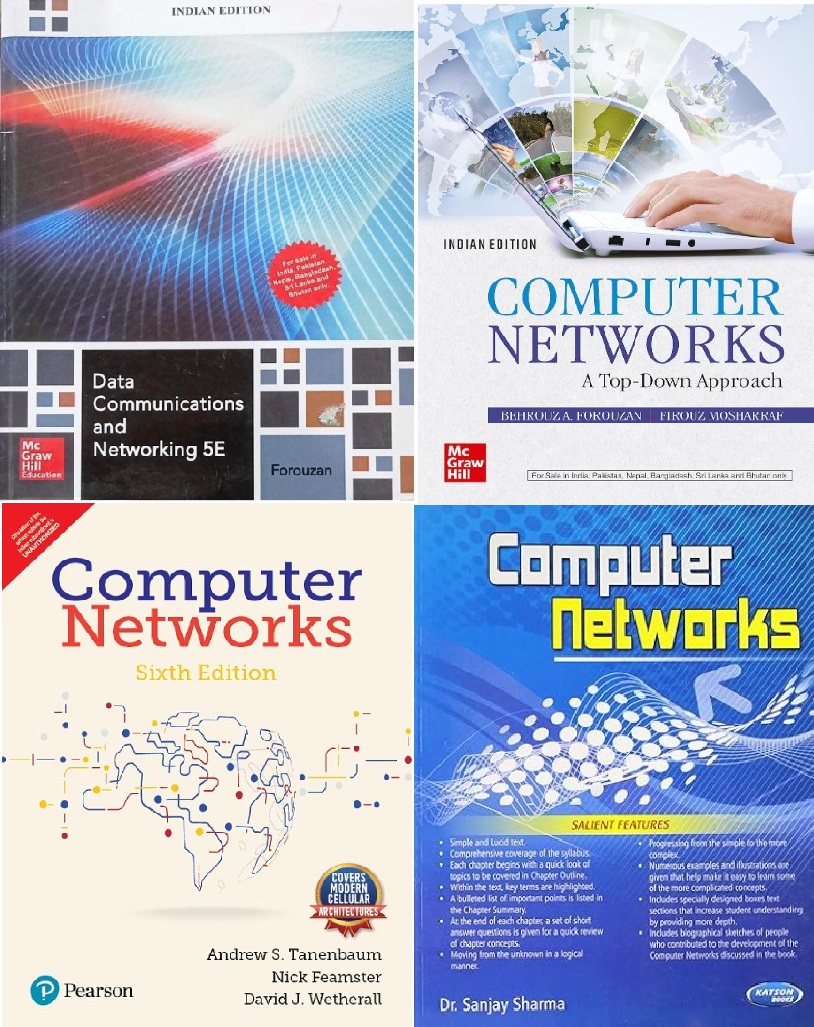Unit 1
Introduction to Data Communication Definition: Effectiveness, Basic Communication Components. Network Architecture Definition, History, Criteria, Goals and Applications of Networks, Categories of networks, Organization of the Internet, ISP, Protocols and standards, The OSI reference model, TCP/IP protocol suite, Network devices and components. Network topology design, Types of connections.
Q21 – What is the primary goal of data communications?
To ensure remote communication only
To exchange data between devices
To limit communication to local networks
To facilitate face-to-face communication
Ans – (2)
Explanation – The text states that data communications involve the exchange of data between two devices via a transmission medium.
Q22 – What is the definition of data?
Information transmitted via telecommunication
Information presented in any agreed-upon form
Information exchanged face-to-face
Information stored in physical equipment
Ans – (2)
Explanation – The text defines data as information presented in whatever form is agreed upon by the parties creating and using the data.
Q23 – What is the purpose of the delivery characteristic in a data communications system?
To ensure data are received accurately
To ensure data are received promptly
To ensure data are received by the correct destination
To ensure even delay in packet arrival time
Ans – (3)
Explanation – Delivery ensures that data are delivered to the intended device or user.
Q24 – What term refers to the variation in packet arrival time in a data communications system?
Delivery
Accuracy
Timeliness
Jitter
Q25 – What is the consequence of data delivered late in a data communications system?
Data become unusable
Data accuracy is compromised
Data security is at risk
Data transmission speed decreases
Ans – (1)
Explanation – Timeliness is crucial in data communications, as late delivery renders the data useless.
Q26 – The _______ is the physical path over which a message travels.
Protocol
Medium
Signal
All of the above
Ans – (2)
Explanation – The medium is the physical path over which a message travels. It can be something like a wire, fiber optic cable, or even air (for wireless communication).
Q27 – Frequency of failure and network recovery time after a failure are measures of the _________ of a network.
Performance
Reliability
Security
Feasibility
Ans – (2)
Explanation – Reliability of a network is measured by how often it fails (frequency of failure) and how quickly it can recover after a failure (network recovery time).
Q28 – An unauthorized user is a network __________ issue.
Performance
Reliability
Security
All of the above
Ans – (3)
Explanation – An unauthorized user accessing a network is a security issue. Security involves protecting the network from unauthorized access, attacks, and ensuring data privacy.
Q29 – In the original ARPANET, _______ were directly connected to each other.
interface message processors (IMPs)
host computers
networks
Routers
Ans – (1)
Explanation – The ARPANET, the precursor to the modern Internet, used Interface Message Processors (IMPs) to connect host computers.
IMPs were essentially early routers that managed the data traffic between connected hosts.
Host computers were connected to these IMPs, and the IMPs were then connected to each other, forming the network’s backbone. This setup allowed for efficient data transmission and network reliability.
Q30 – Which topology requires a multipoint connection?
Mesh
Star
Bus
Ring
Ans – (3)
Explanation – A bus topology requires a multipoint connection because all devices are connected to a single central cable, called the bus, and data is transmitted to all devices on the network along this shared path.
Q31 – Communication between a computer and a keyboard involves ________ transmission.
Simplex
Half-duplex
Full-duplex
Automatic
Ans – (1)
Explanation – Communication between a computer and a keyboard involves simplex transmission, where the data flows in only one direction—from the keyboard to the computer.
Q32 – In a network with 25 computers, which topology would require the most extensive cabling?
Mesh
Star
Bus
Ring
Ans – (1)
Explanation – A mesh topology would require the most extensive cabling in a network with 25 computers. In a mesh topology, each computer is connected to every other computer, resulting in a large number of cables and connections n(n-1)/2 = (25*24)/2 = 300.
Q33 – A television broadcast is an example of _________ transmission.
Simplex
Half-duplex
Full-duplex
Automatic
Ans – (1)
Explanation – A television broadcast is an example of simplex transmission, where the signal is transmitted in only one direction, from the broadcaster to the viewers, with no return path.
Q34 – In _________ transmission, the channel capacity is shared by both communicating devices at all times.
Simplex
Half-duplex
Full-duplex
Automatic
Ans – (3)
Explanation –
In full-duplex transmission, the channel capacity is shared by both communicating devices at all times, allowing simultaneous data transmission in both directions.
Q35 – A cable break in a __________ topology stops all transmission.
Mesh
Bus
Star
Primary
Ans – (2)
Explanation –
A cable break in a bus topology stops all transmission because all devices are connected to a single central cable (Backbone). If this cable is damaged or broken, communication between all devices on the network is disrupted.
Q36 – Which organization has authority over interstate and international commerce in the communication field?
ITU-T
IEEE
FCC
ISO
Ans – (3)
Explanation –
The FCC (Federal Communications Commission) has authority over interstate and international commerce in the communication field within the United States.
ITU-T (International Telecommunication Union Telecommunication Standardization Sector) – ITU-T is a specialized agency of the United Nations that develops technical standards for telecommunications. It works on standardizing the protocols and technologies used in telecommunications networks and services on a global scale.
IEEE (Institute of Electrical and Electronics Engineers) – IEEE is a professional association dedicated to advancing technology for the benefit of humanity. It is known for developing standards in various fields of electrical and electronics engineering, including telecommunications, computing, power and energy, biomedical technology, and more.
ISO (International Organization for Standardization) – ISO is an international standard-setting body composed of representatives from various national standards organizations. It develops and publishes international standards across various industries and sectors to ensure quality, safety, and efficiency in products, services, and systems.
Q37 – How many types of network architecture are used?
4
3
2
1
Ans – (3)
Explanation –
Peer-to-Peer (P2P) – In a peer-to-peer network, all devices on the network have equal status and can communicate directly with each other without the need for a central server. P2P networks are commonly used for file sharing and collaboration among small groups of users.
Client-Server – In a client-server network architecture, there are two types of entities: clients and servers. Clients are devices (such as computers or smartphones) that request services or resources from servers, which are powerful computers that provide those services or resources. This architecture is commonly used in business environments and on the internet.
Q38 – Does the Peer-To-Peer network backup the data?
Yes
No
Ans – (2)
Explanation – Peer-to-peer networks don’t inherently include a built-in mechanism for backing up data. Users must implement their own backup solutions to ensure the safety and availability of their data.
Q39 – Which of the communication modes support two way traffic but in only once direction of a time?
Simplex
Half-duplex
Three – quarter’s duplex
Full duplex
Ans – (2)
Explanation – The communication mode that supports two-way traffic but only in one direction at a time is Half-duplex.
In half-duplex communication, data can be transmitted and received, but not simultaneously in both directions. Instead, communication alternates between transmitting and receiving, allowing for two-way traffic but only in one direction at a time.
Q40 – What is the commonly used unit for measuring the speed of data transmission?
Bytes per second
Baud
Bits per second
Both B and C
Ans – (3)
Explanation – The commonly used unit for measuring the speed of data transmission is Bits per second (bps).
While baud is a measure of the number of signaling events per second in a communication channel, it doesn’t directly equate to the number of bits transmitted per second.
Bits per second (bps) specifically measures the rate at which bits are transmitted in a data stream.



